Editor’s Staff
Independence Hall,
Philadelphia, Pennsylvania
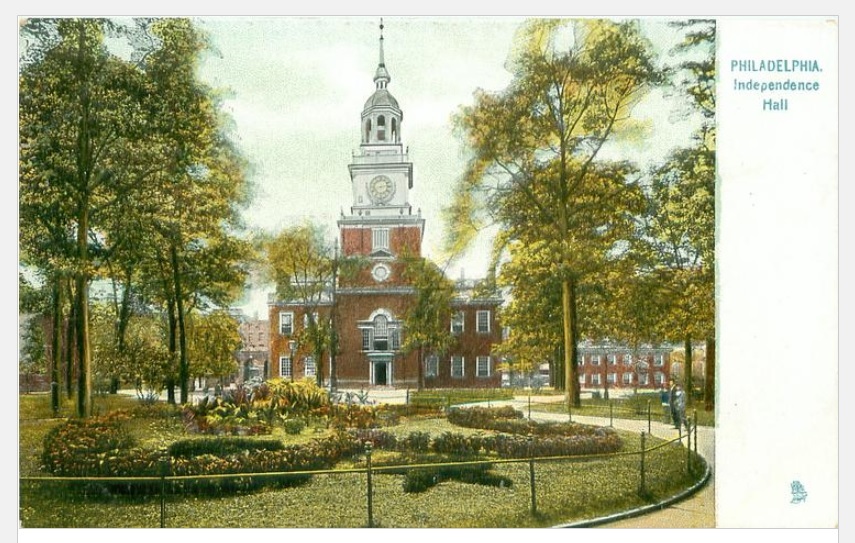
When the Pennsylvania State House was completed in 1753, it was designed and intended as the capitol building for the Commonwealth of Pennsylvania. In the turmoil that became the American Revolution (1775) the building was chosen as a meeting place for the second Continental Congress. It served as the de facto seat of government from 1775 to 1783, and also four years later as the site for the United States Constitutional Convention of 1787.
(For the curious: the first meeting of the U. S. Congress in the national capitol in Washington, D. C., took place on November 17, 1800.)
A long list of important events took place in the Pennsylvania State House, not the least of which were the appointments in 1775 of George Washington and Benjamin Franklin as commander of the continental army and postmaster general respectively.
In 1776 the
Declaration of Independence was approved and read to the public in the square behind the building. The congress discontinued their meetings at the statehouse in December 1776, but they would return, after the British occupation, in the spring and summer of 1777. The last meetings of the continental congress were held at the statehouse from July 1778 to March 1781.
Other important events at this site were:
- the Constitutional Convention in 1787, when the U. S. Constitution was completed. It took effect on March 4, 1789 when the congress met first in New York City. Congressional meetings returned to Philadelphia in 1790 and continued there until the government moved to Washington, D.C. in 1800;
- the funeral-train of Abraham Lincoln made a stop in Philadelphia in April 1865. The president’s coffin was carried by hearse past 85,000 onlookers to the Assembly Room at the State House;
- in 1915 former President William Howard Taft presided over a meeting called to announce the formation of a League to Enforce Peace. The proposed “league” was to be an international body of member nations committed to the mutual safety of the world’s populations and the enforcement of international laws, and;
- throughout the 20th century the hall served both Philadelphia, the nation, and the world as the site of worthy events and a place of frequent announcements of great importance.
The Independence National Historical Park was formulated in 1948 by the 80
th Congress to preserve the historic sites associated with the American Revolution.
* * *
In 1816 when the Commonwealth of Pennsylvania moved the State House to Lancaster, it sold the hall to the City of Philadelphia. It took more than two years to transfer the deed but Philadelphia has owned the State House, its associated buildings, and the grounds since that time.
* * *
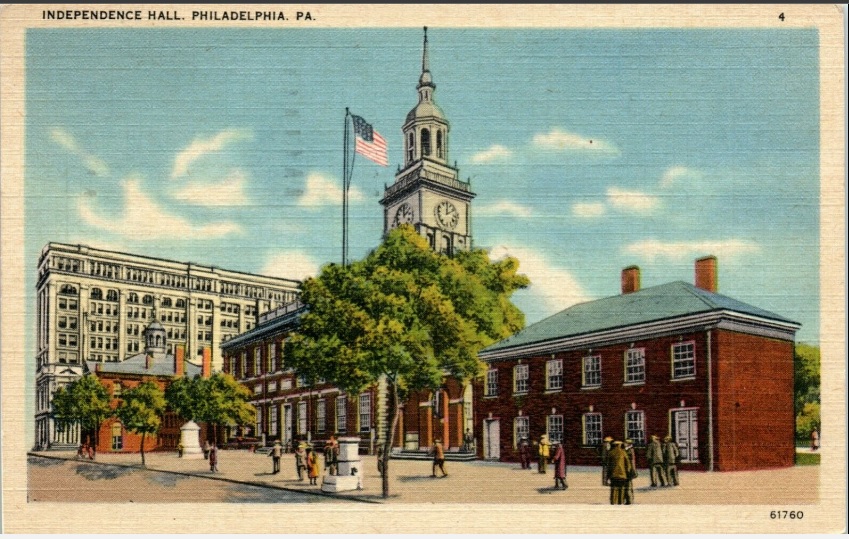
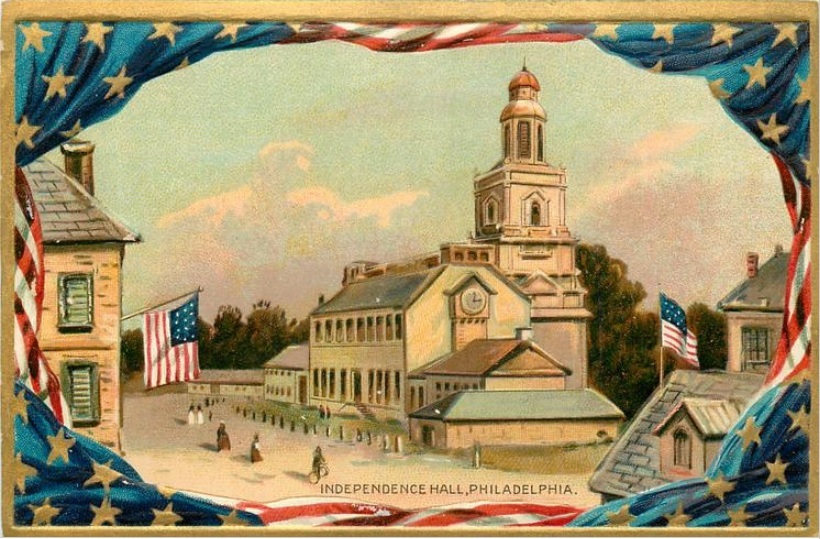
Every era in Postcard History has seen new versions of Independence Hall cards.


Artists are among those who have created some of the most beautiful Independence Hall postcards. To name only a few there were Frederic Kohli, Craig Fildes, Robert Finale, Joachin Ferdinand Reichardt, and Postcard History’s favorite son, H. T. MacNeill. For more history on MacNeill and his unique association with Independence Hall, see Postcardhistory.net (July 26, 2020.)
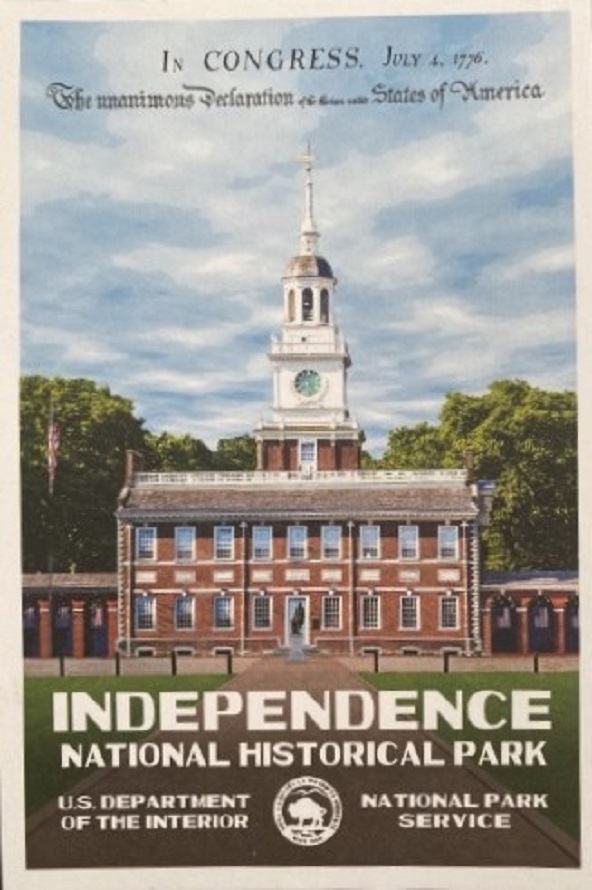
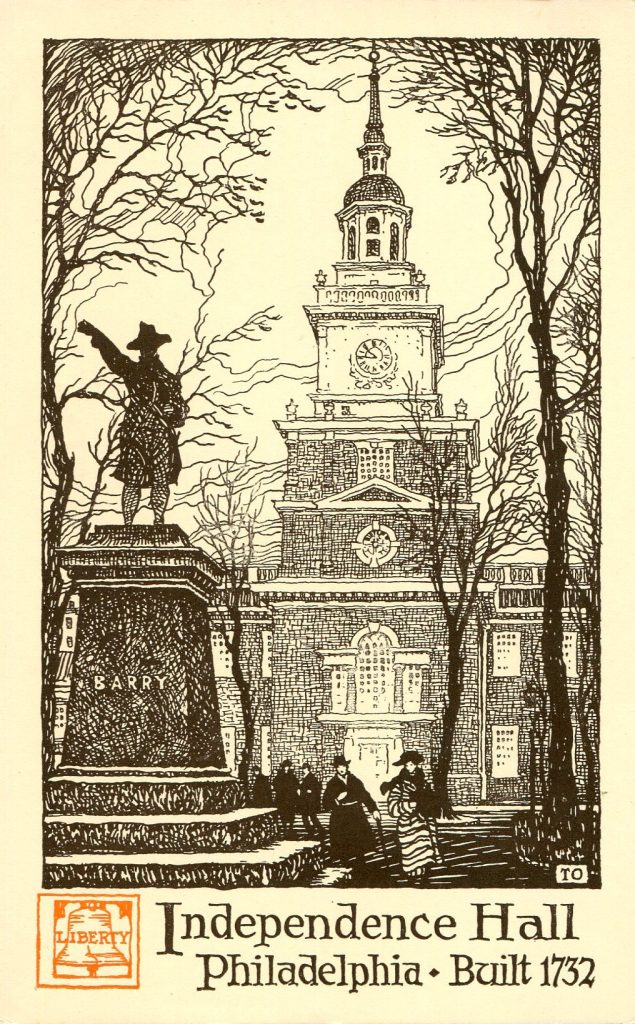
Above left, is a modern card created for the National Park Service, showing Independence Hall as it is seen today. On the right is card No. 9 from a multi-card set published by the Philadelphia Art Alliance. The art is the work of Thornton Oakley.
At the time of his death (1953) Oakley was one of Pennsylvania’s most accomplished illustrators, best known for his drawings of American industrial scenes. He was born in Pittsburg, on March 27, 1881, when the name of the city was spelled without an “h.” As a young man, he moved to Philadelphia to earn a B.S. and M.S. in architecture at the University of Pennsylvania. He completed his schooling in 1902 but made frequent trips to the Brandywine School in Chadd’s Ford, Pennsylvania, to study with Howard Pyle.
Independence Hall has become so much a part of the American legacy that it has appeared on two postage stamps (1974 & 1976), the reverse of the Kennedy half-dollar coin, and on a piece of U. S. currency, the reverse of the one-hundred-dollar bill. Also, on the reverse of the U. S. two-dollar-bill there is an etching based on John Trumbull’s painting of the ceremony at which the Declaration of Independence was signed.
* * *
It would be remiss if this opportunity passed without a mention that Independence Hall is the home of the Liberty Bell.
In the early years of business at the State House, a bell rang from the tower to call legislators to duty. It was commissioned in 1751 by the speaker of the Pennsylvania Assembly, Isaac Norris, from the Whitechapel Foundry in London. Sadly, the Whitechapel bell cracked on the first test ring. Local metalworkers John Pass and John Stow melted down that bell and cast a new one right there in Philadelphia. It is the Pass and Stow bell that would ring to call lawmakers to their meetings around the time of the Revolution, and to call the townspeople together to hear the reading of the news. Benjamin Franklin wrote to Catherine Ray in 1755, “Adieu, the Bell rings, and I must go among the Grave ones and talk Politicks.”
 When the Pennsylvania State House was completed in 1753, it was designed and intended as the capitol building for the Commonwealth of Pennsylvania. In the turmoil that became the American Revolution (1775) the building was chosen as a meeting place for the second Continental Congress. It served as the de facto seat of government from 1775 to 1783, and also four years later as the site for the United States Constitutional Convention of 1787.
(For the curious: the first meeting of the U. S. Congress in the national capitol in Washington, D. C., took place on November 17, 1800.)
A long list of important events took place in the Pennsylvania State House, not the least of which were the appointments in 1775 of George Washington and Benjamin Franklin as commander of the continental army and postmaster general respectively.
In 1776 the Declaration of Independence was approved and read to the public in the square behind the building. The congress discontinued their meetings at the statehouse in December 1776, but they would return, after the British occupation, in the spring and summer of 1777. The last meetings of the continental congress were held at the statehouse from July 1778 to March 1781.
Other important events at this site were:
When the Pennsylvania State House was completed in 1753, it was designed and intended as the capitol building for the Commonwealth of Pennsylvania. In the turmoil that became the American Revolution (1775) the building was chosen as a meeting place for the second Continental Congress. It served as the de facto seat of government from 1775 to 1783, and also four years later as the site for the United States Constitutional Convention of 1787.
(For the curious: the first meeting of the U. S. Congress in the national capitol in Washington, D. C., took place on November 17, 1800.)
A long list of important events took place in the Pennsylvania State House, not the least of which were the appointments in 1775 of George Washington and Benjamin Franklin as commander of the continental army and postmaster general respectively.
In 1776 the Declaration of Independence was approved and read to the public in the square behind the building. The congress discontinued their meetings at the statehouse in December 1776, but they would return, after the British occupation, in the spring and summer of 1777. The last meetings of the continental congress were held at the statehouse from July 1778 to March 1781.
Other important events at this site were:

 Every era in Postcard History has seen new versions of Independence Hall cards.
Every era in Postcard History has seen new versions of Independence Hall cards.

 Artists are among those who have created some of the most beautiful Independence Hall postcards. To name only a few there were Frederic Kohli, Craig Fildes, Robert Finale, Joachin Ferdinand Reichardt, and Postcard History’s favorite son, H. T. MacNeill. For more history on MacNeill and his unique association with Independence Hall, see Postcardhistory.net (July 26, 2020.)
Artists are among those who have created some of the most beautiful Independence Hall postcards. To name only a few there were Frederic Kohli, Craig Fildes, Robert Finale, Joachin Ferdinand Reichardt, and Postcard History’s favorite son, H. T. MacNeill. For more history on MacNeill and his unique association with Independence Hall, see Postcardhistory.net (July 26, 2020.)

 Above left, is a modern card created for the National Park Service, showing Independence Hall as it is seen today. On the right is card No. 9 from a multi-card set published by the Philadelphia Art Alliance. The art is the work of Thornton Oakley.
At the time of his death (1953) Oakley was one of Pennsylvania’s most accomplished illustrators, best known for his drawings of American industrial scenes. He was born in Pittsburg, on March 27, 1881, when the name of the city was spelled without an “h.” As a young man, he moved to Philadelphia to earn a B.S. and M.S. in architecture at the University of Pennsylvania. He completed his schooling in 1902 but made frequent trips to the Brandywine School in Chadd’s Ford, Pennsylvania, to study with Howard Pyle.
Independence Hall has become so much a part of the American legacy that it has appeared on two postage stamps (1974 & 1976), the reverse of the Kennedy half-dollar coin, and on a piece of U. S. currency, the reverse of the one-hundred-dollar bill. Also, on the reverse of the U. S. two-dollar-bill there is an etching based on John Trumbull’s painting of the ceremony at which the Declaration of Independence was signed.
* * *
It would be remiss if this opportunity passed without a mention that Independence Hall is the home of the Liberty Bell.
In the early years of business at the State House, a bell rang from the tower to call legislators to duty. It was commissioned in 1751 by the speaker of the Pennsylvania Assembly, Isaac Norris, from the Whitechapel Foundry in London. Sadly, the Whitechapel bell cracked on the first test ring. Local metalworkers John Pass and John Stow melted down that bell and cast a new one right there in Philadelphia. It is the Pass and Stow bell that would ring to call lawmakers to their meetings around the time of the Revolution, and to call the townspeople together to hear the reading of the news. Benjamin Franklin wrote to Catherine Ray in 1755, “Adieu, the Bell rings, and I must go among the Grave ones and talk Politicks.”
Above left, is a modern card created for the National Park Service, showing Independence Hall as it is seen today. On the right is card No. 9 from a multi-card set published by the Philadelphia Art Alliance. The art is the work of Thornton Oakley.
At the time of his death (1953) Oakley was one of Pennsylvania’s most accomplished illustrators, best known for his drawings of American industrial scenes. He was born in Pittsburg, on March 27, 1881, when the name of the city was spelled without an “h.” As a young man, he moved to Philadelphia to earn a B.S. and M.S. in architecture at the University of Pennsylvania. He completed his schooling in 1902 but made frequent trips to the Brandywine School in Chadd’s Ford, Pennsylvania, to study with Howard Pyle.
Independence Hall has become so much a part of the American legacy that it has appeared on two postage stamps (1974 & 1976), the reverse of the Kennedy half-dollar coin, and on a piece of U. S. currency, the reverse of the one-hundred-dollar bill. Also, on the reverse of the U. S. two-dollar-bill there is an etching based on John Trumbull’s painting of the ceremony at which the Declaration of Independence was signed.
* * *
It would be remiss if this opportunity passed without a mention that Independence Hall is the home of the Liberty Bell.
In the early years of business at the State House, a bell rang from the tower to call legislators to duty. It was commissioned in 1751 by the speaker of the Pennsylvania Assembly, Isaac Norris, from the Whitechapel Foundry in London. Sadly, the Whitechapel bell cracked on the first test ring. Local metalworkers John Pass and John Stow melted down that bell and cast a new one right there in Philadelphia. It is the Pass and Stow bell that would ring to call lawmakers to their meetings around the time of the Revolution, and to call the townspeople together to hear the reading of the news. Benjamin Franklin wrote to Catherine Ray in 1755, “Adieu, the Bell rings, and I must go among the Grave ones and talk Politicks.”
If the first bell was melted down due to its being cracked where did the cracked bell now on display come from?
The second bell cracked sometime in the early nineteenth century — legend claims the rupture occurred as the bell was being tolled to commemorate the death of Chief Justice of the United States John Marshall in 1835.
For the 1907 Jamestown Exposition held in Norfolk, Pennsylvania built a replica of Independence Hall to serve as its pavilion. The exposition was held at Pine Beach at Sewells Point. It drew 300,000 visitors including President Theodore Roosevelt who opened the Exposition in April,1907. The Navy purchased the site of the Exposition in 1917 for a naval base at the start of World War I. Many of the buildings were still standing and put to use by the Navy. Pennsylvania House served as the Commissioned Officer’s Mess until the mid-1970’s. The building still stands today on Admiral’s Row (several other… Read more »
Interesting article with good postcards.Hope you like these postcards of the Declaration of Independance at the Old Boston State House